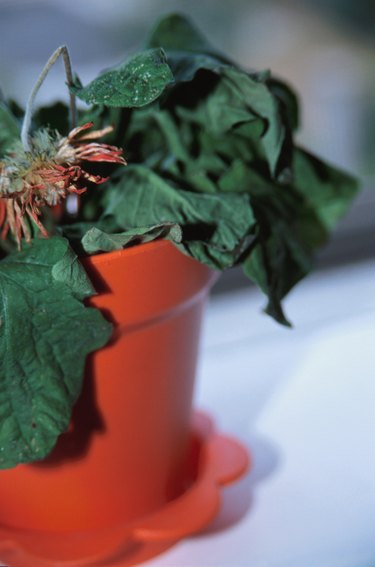
Homeowners often find white grubs inside their kitchens, laundry rooms and bathrooms. Some white grubs also live in the soil of houseplants, where they feed on plant roots and tissue. Grubs found indoors may be the larvae of Indian meal moths, houseflies or fungus gnats. Managing infestations of these pests requires a combination of cultural control methods and insecticides.
Types
Video of the Day
Several species of insects can cause white grublike larvae to be seen inside homes. Fungus gnat larvae live in the potting soil of houseplants. The white grub larvae eventually pupate and turn into adult fungus gnats, which are flying insects that look similar to mosquitoes. Indian meal moths are a kitchen pest, and their larvae are active grublike worms that are white or light pink. The larvae feed on foods in pantries and cupboards and are often seen hanging from ceilings on silky threads. Houseflies are also known as filth flies and are common disease-carrying pests. The larvae of houseflies are creamy white and pupate into adult houseflies.
Video of the Day
Effects
Fungus gnat larvae can cause damage to houseplants as they feed on root hairs. Some houseplants with infestations of fungus gnats experience reduced vigor, stunted growth, and plant death in young seedlings. Fungus gnat larvae also feed on organic matter in the soil, such as fungi. When fungus gnat infestations are heavy, homeowners may see them swarm in clouds over infested plants when they are disturbed. Indian meal moths typically infest cereals, dried fruit, nuts, chocolate, birdseed, dog food and pastas. The larvae can often be found inside food packages, along with frass, which is fecal matter. Adult Indian meal moths are reddish-brown and 3/4 inches in length. Adult moths usually enter homes in infested grocery items. Housefly larvae are usually seen in garbage cans and outdoors in manure and feces. Some housefly larvae may be found indoors near garbage cans and rotting food. Housefly larvae pupate in four to seven days, most rapidly in warm weather. Flies are associated with some diseases that are transmitted through food, such as typhoid fever, conjunctivitis, diarrhea, tuberculosis and dysentery.
Cultural Control
Cultural control methods can help reduce fungus gnat larvae in your houseplants. Avoid overwatering your houseplants, as this promotes fungus gnat development. Allow your houseplants to dry completely before watering again. Using sterile potting soil eliminates fungus gnat development. Repot plants every few months to prevent fungus gnat development in soil that is breaking down. Indian meal moth larvae can be controlled by inspecting all grocery items before bringing them into your home. Do not purchase food items that have been damaged or are torn. If white grubs are seen inside your house, locate the source of infestation and eliminate it. Houseflies are controlled with sanitation practices, such as using garbage cans with tight-fitting lids, using window screens and eliminating breeding sites outside your home. Sticky traps or fly paper can help capture adult flies before they can lay eggs.
Chemical Control
Aerosol sprays may eliminate adult fungus gnats before they can lay their eggs in the soil of your houseplants. Plants heavily infested with fungus gnat larvae may need to be discarded if control cannot be achieved. Indian meal moths can be sprayed with aerosols labeled for use on flying insects, however, this will not control larvae. Insecticides are available for housefly control. Purchase products containing active ingredients such as diazinon, resmethrin or pyrethrins for best results.